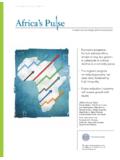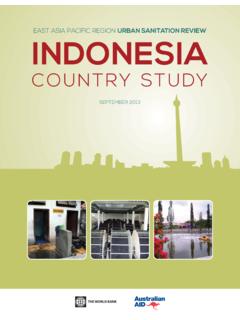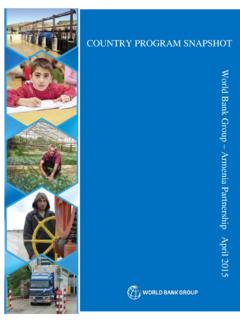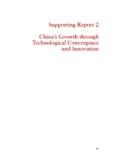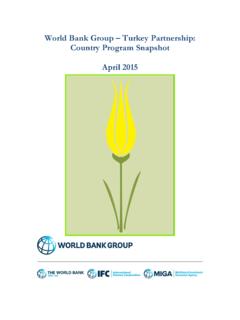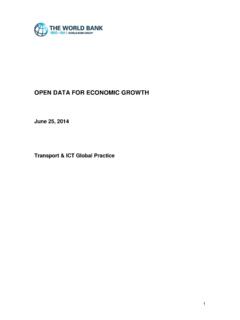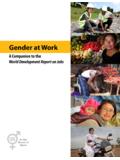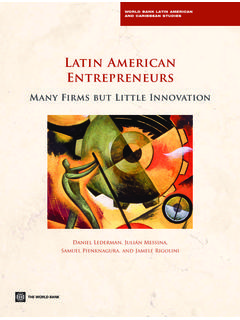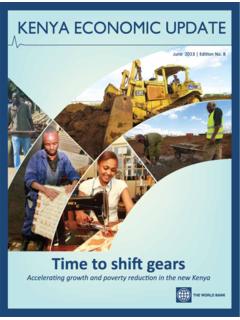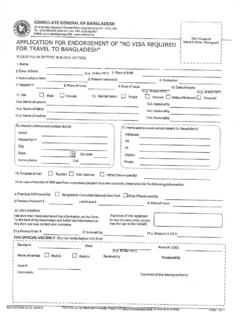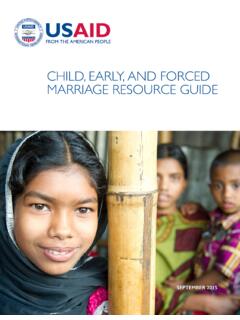Transcription of Poverty - World Bank
1 PovertyAt least once a year, hundreds of millions of parents face a decision about school enrollment. Higher- income parents are probably choosing which school their children will attend or which after-school activ-ities to sign them up for. For many parents in low- income settings, the choice is starker: whether or not to send their child to school at all. Imagine a poor father who chooses not to enroll his son in secondary school. The assumptions policy makers think underlie this decision will likely affect the remedies they design to address low investment in education and other behaviors associated with Poverty . If policy makers assume that Poverty results from poor people s deviant values or character failings as did many antipoverty strategies of the United Kingdom or the United States until well into the 19th century (Narayan, Pritchett, and Kapoor 2009; Ravallion, forth-coming) or that poor people simply do not understand the benefits of important investments like education, they might pursue a strategy of persuasion to assist someone like this father.
2 Or if they assume that the decision to keep a child out of school results solely from a political and economic system that is inherently stacked against poor people, they might advocate quo-tas or a large-scale redistribution of resources. Both these narratives of Poverty offer an incomplete picture of decision making and choice. The first places little emphasis on constraints beyond the control of the decision maker such as the fees associated with attending school or the absence of enforceable com-pulsory education laws, which could coerce parents to send their child to school. The second narrative does not address the cognitive resources required to make a decision, especially when material resources are in short supply and when people s willingness to act upon their desires may be constrained (Mullainathan and Shafir 2013; Perova and Vakis 2013).
3 If this father lives in rural India, for example, he is most likely making his decision in May, nearly five months after the harvest five months after he has earned most of his income for the year. While the returns to secondary education might be high and he might have been able to save funds for tuition, a num-ber of other, more immediate concerns might be com-peting for his attention and his resources. He might have run out of kerosene the day before, or he might need to find materials to patch a hole in his roof. It is one month before the monsoon, so finding clean water requires extra effort. His neighbor might be expecting help with some medical bills, which should not be ignored since this neighbor helped him pay for medi-cine the year before.
4 Even if a more affluent father feels stress about a school enrollment decision, the choice is CHAPTER4 Poverty is not simply a shortfall of money. The constant, day-to-day hard choices associated with Poverty in effect tax an individual s psychological and social resources. This type of tax can lead to economic decisions that perpetuate to trigger concerns about these kinds of basic, day-to-day trade-offs. This chapter offers an alternative set of assumptions for thinking about decision making in contexts of pov-erty and for analyzing why poor people may engage in behaviors that ostensibly perpetuate Poverty , such as borrowing too much and saving too little, underinvest-ing in health and education, and ignoring programs and policies designed to assist them.
5 Recent empirical evidence suggests that these decisions do not arise from deviant values or a culture of Poverty particular to poor people. To the contrary: both poor people and people who are not poor are affected in the same fun-damental way by certain cognitive, psychological, and social constraints on decision making. However, it is the context of Poverty that modifies decision making in important ways. In particular, Poverty is not simply a shortfall of money. The constant, day-to-day hard choices asso ciated with Poverty in effect tax an individual s bandwidth, or mental resources. This cognitive tax, in turn, can lead to economic decisions that perpetuate Poverty . First, Poverty generates an intense focus on the present to the detriment of the future.
6 When poor people must direct their mental resources toward deal-ing with the concerns of Poverty for example, paying off debts or keeping their children safe they have less attention to devote to other important tasks that may be cognitively demanding, such as expending greater and more productive effort at work or making timely investments in education and health (Mullainathan and Shafir 2013). Second, Poverty can also create poor frames through which people see opportunities. Poverty can blunt the capacity to aspire (Appadurai 2004) and to take advantage of the opportunities that do present themselves. Third, the environments of people living in Poverty make additional cognitive demands.
7 The absence of certain physical and social infrastructure that eases cognitive burdens in high-income contexts like piped water, organized child care, and direct deposit and debit of earnings encumbers those living in low- income settings with a number of day-to-day decisions that deplete mental resources even further (Banerjee and Mullainathan 2008). In settings like the United States, for instance, parents rarely need to actively weigh the costs and benefits of school attendance for their children. birth registration systems and the enforcement of truancy laws would counterbalance any internal challenges that might steer parents away from sending their children to school.
8 Moreover, formal credit and insurance markets enable people to rely less on social networks to weather shocks to their health or income. While these considerations may paint an even bleaker picture of Poverty than is familiar to most peo-ple, recent evidence suggests promising interventions for reducing the cognitive, psychological, and social taxes of Poverty . Some of these interventions need not entail complex interventions for influencing the psy-chology or social environments of poor people. Instead, modifications to the process of delivering products and services that take the cognitive taxes of Poverty into account could make existing interventions more effec-tive. Recognizing the cognitive and social dimensions of Poverty could also alter estimates of cost-benefit ratios of policy instruments, such as cash transfers and the development of the infrastructure, institutions, and markets that could serve to lessen the distractions and cognitive burdens of Poverty .
9 Poverty consumes cognitive resources So if you want to understand the poor, imagine yourself with your mind elsewhere. You did not sleep much the night before. You find it hard to think clearly. Self-control feels like a challenge. You are distracted and easily perturbed. And this happens every day. On top of the other material challenges Poverty brings, it also brings a mental one.. Under these conditions, we all would have (and have!) failed. Mullainathan and Shafir, Scarcity: Why Having Too Little Means So Much (2013, 161) She is worried about the future of her children and the struggles they have to face once they grow up. Her immediate concern is to which house she should go for a loan of some food grains for their food that day. Narayan and others, description of a woman in Pedda Kothapalli, India, in Voices of the Poor: Crying Out for Change (2000, 37) The material deprivation that accompanies Poverty has been well documented.
10 The poor are more likely to find themselves in situations in which they must forgo meals or live in substandard housing. They may have many debts to pay off. Their dwellings can be demolished by rain or expropriated by someone more powerful. They might have to collect potable water many times a day. Recent evidence suggests that these 82 World DEVELOPMENT REPORT 2015 This situation of scarcity need not apply solely to those currently living below thresholds of $ or $ per day. It is one that many people in low- income settings may find themselves in at one point or another, as shown in figure Indeed, much of the middle class in low-income countries lives on $2 to $6 a day and thus is still likely to face a number of trade-offs that can trigger a feeling of scarcity.

